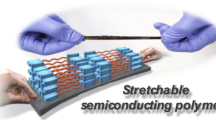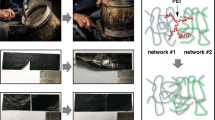Abstract
To modify the flexibility of chitosan (CS), poly(trimethylene carbonate) (PTMC) and its derivatives and copolymers were blended with a chitosan derivative, N,N,N-trimethylchitosan (TM-CS). The tensile strength of the CS and TM-CS films blended with PTMC was found to cause brittleness, but a PTMC derivative copolymer bearing carboxylic acid improved the elongation properties of TM-CS. A softer film was obtained for a blend film composed of TM-CS with 25% consisting of an added PTMC derivative copolymer bearing a 10% carboxylic acid moiety on the side chain. This film showed an elongation at break of 20.6 ± 9.3% with a tensile strength of 2.2 ± 0.83 MPa, while the original CS and TM-CS films showed an elongation at break of 7.4 ± 3.4% and 9.2 ± 1.6% with a tensile strength of 13.6 ± 1.0 MPa and 3.7 ± 0.35 MPa, respectively. This is the first report of the modification of CS using polymers with a PTMC backbone.
This is a preview of subscription content, access via your institution
Access options
Subscribe to this journal
Receive 12 print issues and online access
$259.00 per year
only $21.58 per issue
Buy this article
- Purchase on Springer Link
- Instant access to full article PDF
Prices may be subject to local taxes which are calculated during checkout







Similar content being viewed by others
References
Phillips PJ. Mechanism of orientation of aromatic molecules by stretched polyethylene. Chem Rev. 1990;90:425–36.
Chum PS, Swogger KW. Olefin polymer technologies – History and recent progress at The Dow Chemical Company. Prog Polym Sci. 2008;33:797–819.
Sturzel M, Mihan S, Mulhaupt R. From multisite polymerization catalysis to sustainable materials and all-polyolefin composites. Chem Rev. 2016;116:1398–433.
Malikmammadov E, Tanir TE, Kiziltay A, Hasirci V, Hasirci NPCL. and PCL-based materials in biomedical applications. J Biomater Sci Polym Ed. 2018;29:863–93.
Tempelaar S, Mespouille L, Coulembier O, Dubois P, Dove AP. Synthesis and post-polymerization modifications of aliphatic poly(carbonate)s prepared by ring-opening polymerization. Chem Soc Rev. 2013;42:1312–36.
Sionkowska A. Current research on the blends of natural and synthetic polymers as new biomaterials: Review. Prog Polym Sci. 2011;36:1254–76.
Imre B, Pukanszky B. Compatibilization in bio-based and biodegradable polymer blends. Eur Polym J. 2013;49:1215–33.
Saini P, Arora M, Ravi Kumar MNV. Poly(lactic acid) blends in biomedical applications. Adv Drug Deliv. Rev 2016;107:47–59.
Kun D, Pukanszky B. Polymer/lignin blends: Interactions, properties, applications. Eur Polym J. 2017;93:618–41.
Wang C, Kelley SS, Venditti RA. Lignin-based thermoplastic materials. CHEMSUSCHEM. 2016;9:770–83.
Pillai CKS, Paul W, Sharma CP. Chitin and chitosan polymers: Chemistry, solubility and fiber formation. Prog Polym Sci. 2009;34:641–78.
Liu X, Hu Q, Fang Z, Zhang X, Zhang B. Magnetic chitosan nanocomposites: A useful recyclable tool for heavy metal ion removal. Langmuir. 2009;25:3–8.
Jung CL, Park SC, Lim H. Synthesis of surface-reinforced biodegradable chitosan nanoparticles and their application in nanostructured antireflective and self-cleaning surfaces. ACS Appl Mater Interf. 2019;11:40835–41.
Zhou X, Wang H, Zhang J, Li X, Wu Y, Wei Y, et al. Functional poly(ε-caprolactone)/chitosan dressings with nitric oxide-releasing property improve wound healing. Acta Biomaterialia. 2017;54:128–37.
Zhao X, Wu H, Guo B, Dong R, Qiu Y, Ma PX. Antibacterial anti-oxidant electroactive injectable hydrogel as self-healing wound dressing with hemostasis and adhesiveness for cutaneous wound healing. Biomaterials. 2017;122:34–47.
Sarasam AR, Krishnaswamy RK, Madihally SV. Blending chitosan with polycaprolactone: effects on physicochemical and antibacterial properties. Biomacromolecules. 2006;7:1131–8.
Yang J, Li M, Wang Y, Wu H, Zhen T, Xiong L, et al. Double cross-linked chitosan composite films developed with oxidized tannic acid and ferric ions exhibit high strength and excellent water resistance. Biomacromolecules. 2019;20:801–12.
Kwon S, Park JH, Chung H, Kwon IC, Jeong SY, Kim IS. Physicochemical characteristics of self-assembled nanoparticles based on glycol chitosan bearing 5β-cholanic acid. Langmuir. 2003;19:10188–93.
Razi MA, Wakabayashi R, Goto M, Kamiya N. Self-assembled reduced albumin and glycol chitosan nanoparticles for paclitaxel delivery. Langmuir. 2019;35:2610–8.
Sashiwa H, Yamamori N, Ichinose Y, Sunamoto J, Aiba S. Chemical modification of chitosan 17. Macromol Biosci. 2003;3:231–3.
Jayakumar R, Prabaharan M, Nair SV, Tokura S, Tamura H, Selvamurugan N. Novel carboxymethyl derivatives of chitin and chitosan materials and their biomedical applications. Prog Mater Sci. 2010;55:675–709.
Kim CH, Choi JW, Chun HJ, Choi KS. Synthesis of chitosan derivatives with quaternary ammonium salt and their antibacterial activity. Polym Bull. 1996;38:387–93.
Rúnarsson ÖV, Holappa J, Nevalainen T, Hjálmarsdóttir M, Järvinen T, Loftsson T, et al. Antibacterial activity of methylated chitosan and chitooligomer derivatives: Synthesis and structure activity relationships. Eur Polym J. 2007;43:2660–71.
Kadokawa J, Shimohigoshi R, Yamashita K, Yamamoto K. Synthesis of chitin and chitosan stereoisomers by thermostable α-glucan phosphorylase-catalyzed enzymatic polymerization of α-d-glucosamine 1-phosphate. Org Biomol Chem. 2015;13:4336–43.
Li J, Zivanvic S, Davidson PM, Kit K. Characterization and comparison of chitosan/PVP and chitosan/PEO blend films. Carbohydr Polym. 2010;79:786–91.
You J, Xie S, Cao J, Ge H, Xu M, Zhang L, et al. Quaternized chitosan/poly(acrylic acid) polyelectrolyte complex hydrogels with tough, self-recovery, and tunable mechanical properties. Macromolecules. 2016;49:1049–59.
Wan Y, Wu H, Yu A, Wen D. Biodegradable polylactide/chitosan blend membrances. Biomacromolecules. 2006;7:1362.
Tempelaar S, Mespouille L, Coulembier O, Dubois P, Dove AP. Synthesis and post-polymerisation modifications of aliphatic poly(carbonate)s prepared by ring-opening polymerization. R Soc Chem. 2013;42:1312–36.
Ajiro H, Takahashi Y, Akashi M. Thermosensitive biodegradable homopolymer of trimethylene carbonate derivative at body temperature. Macromolecules. 2012;45:2668–74.
Nederberg F, Zhang Y, Tan JPK, Xu K, Wang H, Yang C, et al. Biodegradable nanostructures with selective lysis of microbial membranes. Nat Chem. 2011;3:409–14.
Zhao C, Shao L, Lu J, Deng X, Wu Y. Tumor acidity-induced sheddable polyethylenimine-poly(trimethylene carbonate)/DNA/polyethylene glycol-2,3-dimethylmaleicanhydride ternary complex for efficient and safe gene delivery. ACS Appl Mater Inter. 2016;8:6400–10.
Fukushima K. Poly(trimethylene carbonate)-based polymers engineered for biodegradable functional biomaterials. Biomater Sci 2016;4:9–24.
Chanthaset N, Ajiro H. Preparation of thermosensitive biodegradable hydrogel using poly(5-[2-{2-(2-methoxyethoxy)ethyoxy}-ethoxymethyl]−5-methyl-1,3-dioxa-2-one) derivatives. Materialia.2019;5:100178
Liu D, Lia H, Zhoua G, Yuana M, Qin Y. Biodegradable poly(lactic‐acid)/poly(trimethylene‐carbonate)/laponite composite film: development and application to the packaging of mushrooms (Agaricus bisporus). Polym Adv Technol. 2015;26:1600–7.
Choi J, Kwak SY. Synthesis and characterization of hyperbranched poly(ε-caprolactone)s having different lengths of homologous backbone segments. Macromolecules. 2003;36:8630–7.
Ariga T, Tanaka T, Endo T. Alkyl halide‐initiated cationic polymerization of cyclic carbonate. J Polym Sci Part A: Polym Chem. 1993;31:581–4.
Mady MF, Charoensumran P, Ajiro H, Kelland MA. Synthesis and characterization of modified aliphatic polycarbonates as environmentally friendly oilfield scale inhibitors. Energ Fuels. 2018;32:6746–55.
Al-Azemi TF, Harmon JP, Bisht KS. Enzyme-catalyzed ring-opening copolymerization of 5-methyl-5-benzyloxycarbonyl-1,3-dioxan-2-one (MBC) with trimethylene carbonate (TMC): synthesis and characterization. Biomacromolecules. 2000;1:493–500.
Sébastien F, Stéphane G, Copinet A, Coma V. Novel biodegradable films made from chitosan and poly(lactic acid) with antifungal properties against mycotoxinogen strains. Carbohydr Polym. 2006;65:185–93.
Zhanga J, Tana W, Zhang Z, Song Y, Li Q, Dong F. Guo Z. Int J Biol Macromol. 2018;109:1061.
Cazóna P, Velázqueza G, Vázquez M. Characterization of bacterial cellulose films combined with chitosan and polyvinyl alcohol: Evaluation of mechanical and barrier properties. Carbohydr Polym. 2019;216:72–85.
Nobuoka H, Ajiro H. Development of ester free type poly(trimethylene carbonate) derivatives with pendant fluoroaromatic groups. Macromol Chem Phys. 2019;220:1900051.
Kulig D, Zimoch-Korzycka A, Jarmoluk A, Marycz K. Study on alginate–chitosan complex formed with different polymers ratio. Polymers. 2016;8:167.
Cao J, Li J, Chen Y, Zhang L, Zhou J. Dual physical crosslinking strategy to construct moldable hydrogels with ultrahigh strength and toughness. Adv Funct Mater. 2018;28:1800739.
Mi FL, Wu YY, Lin YH, Sonaje K, Ho YC, Chen CT, et al. Oral delivery of Ppeptide drugs using nanoparticles self-assembled by poly(γ-glutamic acid) and a chitosan derivative functionalized by trimethylation. Bioconjugate Chem. 2008;19:1248–55.
Alhwaige AA, Ishida H, Qutubuddin S. Poly(benzoxazine-f-chitosan) films: The role of aldehyde neighboring groups on chemical interaction of benzoxazine precursors with chitosan. Carbohydr Polym. 2019;209:122–9.
Neto RJG, Genevro GM, Paulo LA, Lopes PS, Moraes MA, Beppu MM. Characterization and in vitro evaluation of chitosan/konjac glucomannan bilayer film as a wound dressing. Carbohydr Polym. 2019;212:59–66.
Chen M, Runge T, Wang L, Li R, Feng J, Shu XL, et al. Hydrogen bonding impact on chitosan plasticization. Carbohydr Polym. 2018;200:115–21.
Acknowledgements
This work is partly supported by the Bilateral program: Joint Research Thailand-Japan (JSPS-NRCT), Grant Number JPJSBP120189206. This work was supported by JSPS KAKENHI Grant-in-Aid for Scientific Research (B), Grant Number JP20H02799.
Author information
Authors and Affiliations
Corresponding author
Ethics declarations
Conflict of interest
The authors declare no competing interests.
Additional information
Publisher’s note Springer Nature remains neutral with regard to jurisdictional claims in published maps and institutional affiliations.
Supplementary information
Rights and permissions
About this article
Cite this article
Irikura, K., Ekapakul, N., Choochottiros, C. et al. Fabrication of flexible blend films using a chitosan derivative and poly(trimethylene carbonate). Polym J 53, 823–833 (2021). https://doi.org/10.1038/s41428-021-00470-6
Received:
Revised:
Accepted:
Published:
Issue Date:
DOI: https://doi.org/10.1038/s41428-021-00470-6



